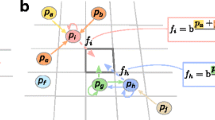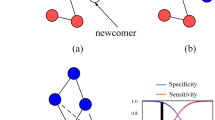Abstract
We propose a simple mechanism based on taxes and subsidies to enhance high cooperation in evolutionary networks. The interactions among agents are based on the Spatial Prisoners' Dilemma game in which each agent interacts with the same strategy with its local neighbors, collects an aggregate payoff and imitates the strategy of its best neighbor. First we study the mechanism in a regular lattice where it is well-known that the asymptotic fraction of cooperators fluctuates around a constant value for almost all starting proportions and configurations of cooperators. We also explore the mechanism in random and adaptive networks, where adaptability refers to the ability of agents to change their local neighborhood. For theses networks it has been reported that the starting proportion of cooperation has to be sufficiently high in order to obtain highly cooperative levels in the long-run time. The implementation of our mechanism produces successful results in such evolutionary networks, higher levels of cooperation are reached for all initial fractions of cooperation, including the most adverse case of just one cooperator in the network. Additionally, we observe that the network reaches a spatial configuration such that the fraction of cooperators remains in high level even when the mechanism is switched off. As a result the mechanism can work as an ignition engine to achieve highly cooperative level since it can be implemented for a finite period of time.
Similar content being viewed by others
References
Abramson, G. and Kuperman, M. (2001). Social games in a social network. Phys. Rev. E, 63, 030901.
Doebeli, M. and Hauert, Ch. (2005). Models of cooperation based on the Prisoner's Dilemma and the Snowdrift game. Ecology Letters, 8, 748–766.
Eguíluz, V.M., Zimmermann, M.G., Cela-Conde, C.J. and San Miguel, M. (2005). Cooperation and the emergence of role differentiation in the dynamical of social networks. Amer. J. Soc. 110, 977–1008.
Hanaki, N., Peterhansl, A., Dodds, P.S. and Watts, D.J. (2005). Cooperation in evolving social networks. Working Paper.
Lindgren, K. and Nordahl, M.G. (1994). Evolutionary dynamics of spatial games. Physica D, 75, 292–309.
Nowak, M. and May, R. (1992). Evolutionary games and spatial chaos. Nature, 359, 826–8829.
Nowak, M. and May, R. (1993). Spatial dilemmas of evolution. Int. Adv. Complex Syst. 5, 35–78.
Vriend, N. (2005). ACE Models of Endogenous Interactions. To appear in K.L. Judd and L. Tesfatsion (Eds.), Handbook of Computational Economics. Volume 2: Agent-Based Computational Economics., North-Holland.
Zimmermann, M., Eguíluz, V. and San Miguel, M. (2001). Cooperation, adaptation and the emergence of leadership. In A. Kirman and J-B Zimmermann (Eds.), Economics with Heterogeneous Interacting Agents. Lecture Notes in Economics and Mathematical Systems, N503, 73–86. Springer.
Zimmermann, M.G., Eguíluz, V.M. and San Miguel, M. (2004), Coevolution of dynamical states and interactions in dynamic networks. Phys. Rev. E, 69, 065102.
Author information
Authors and Affiliations
Corresponding author
Rights and permissions
About this article
Cite this article
Lugo, H., Jiménez, R. Incentives to Cooperate in Network Formation. Comput Econ 28, 15–27 (2006). https://doi.org/10.1007/s10614-006-9033-7
Received:
Accepted:
Published:
Issue Date:
DOI: https://doi.org/10.1007/s10614-006-9033-7




